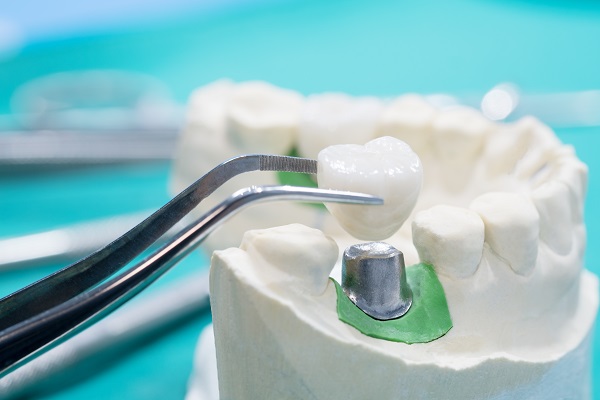What Is a Dental Crown?

Whether you need a root canal or have decay, your dentist may recommend you get a dental crown. However, you might be wondering what a dental crown is. A crown can restore the appearance and function of your natural tooth. It is a way of saving your tooth, which can be preferable to getting an extraction. Read on to learn more about what dental crowns are.
What a dental crown is
A crown is a cap that goes over the top of the tooth. It covers the entire visible portion of the patient's tooth. The crown can be made from one of several types of materials. These materials can include porcelain, metal, composite resin, or porcelain and metal together. The dentist will often choose a material that closely matches the natural teeth. Several things will go into deciding what material to use, including:
- The location and the function of the tooth
- The gum tissue's position
- The patient's preference
- The shade or color of the tooth
Why get a dental crown?
There are several reasons why a patient might need to have a dental crown. One reason is to cover a tooth with a cavity that is too large to get a filling. Worn teeth can also benefit from crowns. For example, patients who grind their teeth may have worn molars, and these can benefit from crowns.
After a root canal treatment, a patient will receive a crown. The tooth's pulp is removed and replaced with a filling inside the tooth. However, the crown will help protect the tooth from being damaged. A poorly shaped tooth can benefit from the protection of a crown as well. In addition, it can improve the patient's overall smile.
Patients who get bridges may also receive dental crowns. A bridge is a set of one or more false teeth. The dentist places a bridge to close the gap left by a missing tooth. A patient may receive a crown on the teeth on both sides of the gap. The bridge can then be attached to each of these crowns.
Crowns and dental implants
Patients who are getting dental implants may also receive crowns. Placing these is a little different than when the crown goes over an existing tooth. Instead, the dentist will place the implant's base in the patient's jaw. The crown is the false tooth that goes over the implant after healing. There is an attachment that connects the implant with the dental crown called an abutment.
Preparing for a dental crown
Preparing for a dental crown
Typically, it will take two visits to prepare for a dental crown. During the first visit, the dentist will examine the tooth that will receive the dental crown. First, X-rays are taken of the tooth and the bone around it. Then, the general dentist will file down the tooth on the top and sides. This process makes space for the crown to sit on the tooth. The amount filed away depends on the type of crown that a patient receives. For example, all-metal dental crowns are typically thinner and do not need as much of the tooth removed as all-porcelain or porcelain-fused-to-metal crowns.
After reshaping the tooth, a paste or putty is used to make a copy of it, also known as an impression. Impressions are made to ensure that the crown will not affect the patient's ability to bite down and chew. The impressions are then sent to a laboratory where the crown is made in a process that takes about two weeks. Meanwhile, the dentist gives the patient a temporary crown to protect the tooth until the permanent crown is ready.
The second visit
At the second visit, the dentist will place the permanent crown on the patient's tooth. Then, they will remove the temporary crown and check to ensure the permanent crown's color and fit. In some cases, the dentist will use a local anesthetic to numb the tooth when they permanently cement the new crown to the tooth.
Same-day dental crowns
In some dental offices, general dentists can make a crown with the proper equipment. While similar to the two separate visit process, during a same-day procedure, the dentist will use a wand-shaped scanning device to take a 3D digital model of the tooth receiving the crown. The digital model is then sent to another in-office machine that carves the shape of the crown out of a ceramic block. In less than 15 minutes, the permanent crown will be ready for the dentist to cement into place.
Visit a dentist today for a dental crown
A dental crown has a variety of uses. It is often used to protect your tooth after a root canal treatment. However, a dental crown can also be used to improve the appearance of your tooth. If your tooth is not attractive, a crown can improve its appearance. If you believe your smile may benefit from one or more crowns, visiting a dentist is your first step.
Request an appointment here: https://www.carmelsmilesdentist.com or call Smiles in the Village Dentistry at (317) 218-7985 for an appointment in our Carmel office.
Check out what others are saying about our dental services on Yelp: Dental Crowns in Carmel, IN.
Related Posts
Proper care of a dental crown is essential for maintaining its appearance, function, and longevity. A dental crown restores damaged or weakened teeth, providing durability and protection to the underlying tooth structure. Although crowns are designed to withstand chewing forces, taking specific precautions ensures their long-term success and helps maintain oral health.A dental crown acts…
A dental crown can restore a damaged, worn, or weakened tooth. This restoration can bring back your healthy smile and stable dental function. Knowing the benefits of dental caps can motivate you to set an appointment soon. Here are the benefits of a dental crown that you must consider.Losing a tooth can be annoying, especially…
Many times, dental crowns are used to repair weakened or damaged teeth, especially those impacted by severe decay. However, this type of treatment also has a place in cosmetic dentistry. It can often be used to improve the overall look of a patient's smile.While at first glance they can seem like little more than a…
If you have broken, cracked, worn, or missing teeth, dental crowns may be used to help restore the look and function of your teeth. If you are unfamiliar with what crowns are and how they work, this guide will help.Dental crowns are teeth-shaped caps that go over a tooth or a dental implant. Once in…


